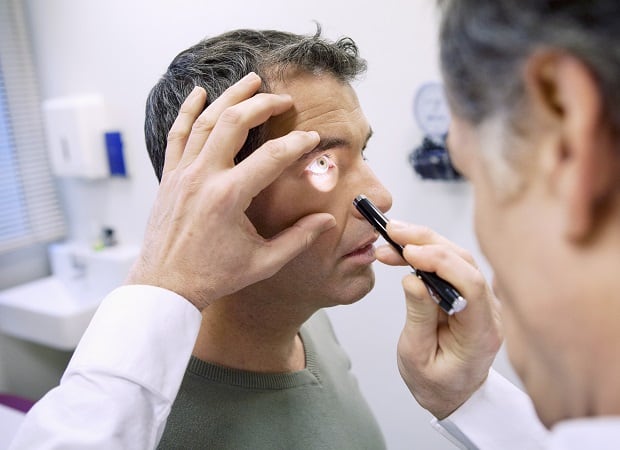
Diabetic Eye Care for Clearwater, & St Petersburg FL
Diabetes occurs when a person’s body is unable to control blood sugar in a normal fashion. With type 1 diabetes, it doesn’t produce enough insulin and their blood sugar is then allowed to reach dangerously high levels. With type 2 diabetes, they produce enough insulin but the body is unable to utilize it so it responds by producing more insulin. Blood sugar levels may reach abnormal levels in response.
Whenever there is too much sugar in the blood, it interferes with normal blood flows, especially in tiny blood vessels like those found in the retina of the eye. While this can result in complete vision loss, in about 90% of cases, vision loss can be prevented with a good diet, plenty of exercise, keeping blood sugar levels at normal levels and receiving regular eye examinations that catch problems as soon as they start.

Diabetic Eye Symptoms
If you have been diagnosed with diabetes, you should be very alert for any of these symptoms:
- Blurred vision
- Floaters (threadlike shapes passing through your vision)
- Shadows in your field of view
- Eye pain
- Light flashes
Another symptom of diabetic eye problems is sudden vision loss. But remember, good care for your overall health and your eyes can prevent this for most people.
While some people with diabetes may develop cataracts or glaucoma, a condition called diabetic retinopathy is more common. As blood sugar interferes with the retina’s blood vessels, they become weakened and begin to leak, forming small hemorrhages. The retina may begin to swell.
As the condition progresses, the body tries to grow new blood vessels but they will be fragile and leak blood into the clear fluid that fills the eye. Finally, this condition can cause the retina to detach from the back of the eye or even damage the optic nerve.

Diagnosis Of Diabetic Eye Problems
As you can see, diabetic eye problems can get very serious. To check for these problems, your doctor will photograph the back of your eye with a special camera to look for changes.
Another test involves injecting a dye into the blood so problems in these blood vessels can be detected.

Types Of Diabetic Eye Disease
Both type 1 and type 2 diabetes put you at higher risk for certain eye diseases and complications that may lead to blindness if left untreated. Diabetic eye disease is a group of eye problems that affect this population. The longer you live with diabetes, the more likely you are to experience vision changes and vision loss.
Diabetes damages the blood vessels in your eye when you have high blood glucose (sugar) levels. While short-term high blood sugar only causes temporary vision changes, such as blurry vision, long-term uncontrolled diabetes can wreak havoc on your eyesight.
The increased blood glucose levels damage the tiny blood vessels in the back of your eye, and these issues can arise before you know you have diabetes or are considered “prediabetic.” The damaged vessels can leak fluid and swell, and new, weak blood vessels grow in their place. These growths can bleed into the middle of the eye, cause scarring and increase eye pressure to dangerous levels.
There are four types of diabetic eye diseases, as follows:
Diabetic Retinopathy
The retina is the light-sensitive tissue lining the back of your eyes. Diabetic retinopathy happens when the damaged blood vessels affect the retina by bulging or leaking into the tissue. Late-stage (proliferative) diabetic retinopathy occurs when the newer, weaker blood vessels “proliferate” or grow on the retina’s surface, causing vision loss. Someone with diabetic retinopathy may see dark or black spots in their field of vision.
Diabetic Macular Edema
The macula is a part of the retina in charge of your central vision. Diabetes complications can cause the macula to swell, leading to diabetic macular edema. Damage caused by this disease includes central vision loss and blindness and often develops after diabetic retinopathy.
Glaucoma
This group of eye diseases harms the optic nerve through abnormally high intraocular eye pressure. The optic nerve sends signals from the retina to the brain to transform light into images. People with diabetes are twice as likely to develop glaucoma, which can cause significant vision loss and blindness. Treatments can’t reverse vision loss caused by glaucoma but may prevent further damage.
Cataracts
Cataracts are a normal part of aging for most people and occur when proteins build up inside the eye’s natural lens. However, people with diabetes are more likely to have cataracts at a younger age. This link isn’t fully understood, but scientists believe high blood sugar can cause deposits to clump together in the eye, causing blurry vision, double vision and an opaque appearance. Cataracts are highly curable with cataract surgery.
How To Prevent Diabetic Eye Disease
The best way to prevent diabetic eye disease is to manage diabetes and lead a healthy lifestyle. The “diabetes ABCs” include blood sugar, blood pressure and cholesterol, and managing these concerns can maintain your ocular health and overall well-being. Eating a good diet and regular exercise can significantly improve your odds of diabetic eye disease. Quitting smoking is another way to prevent these conditions and annual dilated eye exams.
Why You Need Eye Exams
Dilated eye exams are an essential tool in your arsenal that protect your eyes from diabetes complications. These comprehensive exams can identify damage from high blood sugar before you experience symptoms and even before you’re diagnosed with diabetes. Many people don’t know they have diabetes and may experience vision changes or loss before being diagnosed. An eye exam finds these concerns before they cause significant vision loss — when they’re more treatable. Dilated eye exams are crucial for the early diagnosis and treatment of diabetic eye disease.
Diabetic Eye Treatment Details
It’s vital to follow your recommended schedule of eye exams so treatment can be started immediately if problems show up.
Treatment may consist of using a laser to make more than a thousand tiny burns in the outer edges of the retina. The purpose of these burns is to close up damaged blood vessels. Some of the peripheral vision is lost but this treatment can halt the progression of diabetic retinopathy. This treatment is called pan retinal photocoagulation.
If too much blood has already leaked from these tiny arteries into the fluid that fills the eye – called vitreous gel – this gel must be removed and replaced with sterile saline solution. This procedure is called vitrectomy surgery.
At St. Michael’s Eye & Laser Institute, Dr. John Michaelos, his father Dr. John Michaelos and their colleagues are ready to help you protect and preserve your eyesight. If you have been diagnosed with diabetes, please contact us so we can help you with regular examinations that detect problems as soon as they show up. Please call 727-585-2200 today to schedule an appointment.
 Patient Portal
Patient Portal  Online Payment
Online Payment  Doctor Referral
Doctor Referral  Financing
Financing 

